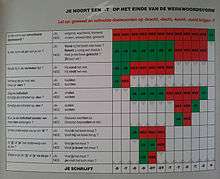DT-Manie
DT-Manie is a linguistical problem in Dutch spelling, created by the first official modern Dutch spelling rules published in 1954 for the Netherlands and for Flanders.
Background
Since 1954 and the introduction of the first legalised official modern Dutch spelling rules for the Netherlands and Flanders, the Dutch speaking community faced a problem with the identification of the correct ending to their verbs. Should there be a ‘d’, ‘dd’, ‘t’, ‘tt’ or ‘dt’? This problem caused numerous problems in schools and when writing applications for jobs.[1]
As can be seen in these examples, the ending of these Dutch verbs alter accordingly to the tense, persons, numbers etc. and it was this rule that caused problems for children and adults alike as 'd', 'dt', and 't' at the end are all pronounced as t.
- Ik antwoord (I answer),
- jij antwoordt (you answer),
- antwoord jij (answer you = do you answer?),
- hij/zij antwoordt (he/she answers),
- ik/jij/hij heb/heeft geantwoord (I / you / he have / has answered),
- ik/jij/hij antwoordde (I / you / he answered),
- Antwoord! (Answer!),
- Antwoordt! (Answer! said to more than 1 person - archaic),
- antwoorden (to answer),
- de beantwoorde vraag (the answered question).
- The situation was further complicated in the archaic language:
- Gij hadt geantwoord (You had answered; gij is now mostly used regionally or for God)
- Dat hij antwoorde! (That he may answer; the subjunctive is now only very rarely used)
Solution
A solution was found in the Department of Linguistics at K.U.Leuven, in 1991 by Jeannine Beeken.[2] She developed a minimal set of rules giving the enquirer the opportunity to answer only a few questions to identify the correct ending. As a visualised algorithm, DT-Manie, always gives the user the correct answer, as long as all of the yes/no-questions are answered correctly. It gives all the correct spellings for each Dutch verb for all moods, tenses, persons and numbers. It presents the simple solution of the biggest spelling problem of Dutch, i.e. the conjugation of verbs, esp. the so-called ‘DT rule’.

Media interest
A leaflet called ‘DT Mania’ was printed for more than 100,000 Flemish secondary-school pupils. When the spelling algorithm hit the 8 o’clock news however, thousands of people phoned to obtain one or more copies of the leaflet, resulting in a breakdown of the phone system in the whole city of Leuven. Because the hospitals, fire brigade and police etc. could no longer be reached by phone, there was a special news edition later that evening, asking people to only phone two phone numbers, especially set up for the occasion. During the first week of its appearance, more than half a million of copies were posted for free.
References
Bibliography
- BEEKEN, J. (1990, 1991) DT-Manie: een spellingsalgoritme voor werkwoordsvormen (DT-Manie: a spelling algorithm for forms of verbs), 14/11, Eekhoutcentrum Kortrijk.
- BEEKEN, J. & D. SPEELMAN (1995) DT-Manie 1.0 (software), Wolters, Leuven.
- DRIESSENS, Koen. (1992) 'Het is beter de regels te kennen dan ze te wijzigen', Het Belang Van Limburg, 8 Mei, p. 43.
- D, W. (1992) 'Handig vouwblaadje moet dt-fouten uitroeien De theedrinker leest DT-manie', Het Volk/DNG, p. 7.
- S.(1992) 'DT-Manie', Klasse. No.25 Mei, p. 34.